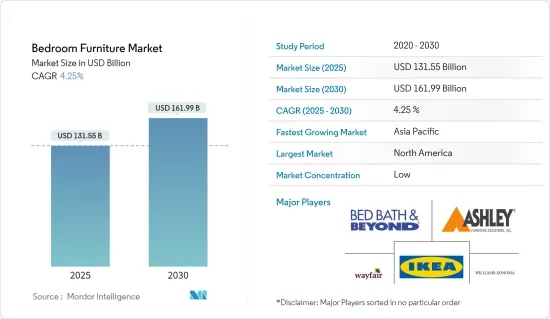
|
市場調査レポート
商品コード
1642039
寝室用家具:市場シェア分析、産業動向・統計、成長予測(2025~2030年)Bedroom Furniture - Market Share Analysis, Industry Trends & Statistics, Growth Forecasts (2025 - 2030) |
||||||
カスタマイズ可能
適宜更新あり
|
|||||||
| 寝室用家具:市場シェア分析、産業動向・統計、成長予測(2025~2030年) |
|
出版日: 2025年01月05日
発行: Mordor Intelligence
ページ情報: 英文 120 Pages
納期: 2~3営業日
|
- 全表示
- 概要
- 目次
寝室用家具の市場規模は2025年に1,315億5,000万米ドルと推定され、予測期間中(2025-2030年)のCAGRは4.25%で、2030年には1,619億9,000万米ドルに達すると予測されます。

同市場の今後の成長見通しは、多目的家具に対する需要の高まりによって支えられると予想されます。また、生活水準の向上も市場拡大に拍車をかけており、高級品の発売を後押ししています。世界人口の増加により、特に都市部では不動産価格が世界的に大幅に下落しています。そのため、家の大きさは大幅に縮小しています。
顧客は、縮小する空間のスペースを最大限に活用するために、持ち運び可能な小型家具を探しています。ベンダー各社は、こうしたニーズに応えるため、収納スペースを備えた多目的家具を製造しています。テーブルやマットレスなど、最近の家具のほとんどには収納スペースが追加されています。住まいや暮らしのコンセプトや動向の進化によって、顧客は購買パターンを変えつつあります。ホームスタイル、ライフスタイル、ファッションの雑誌やブログが顧客に影響を与えています。
寝室用家具の市場動向
市場を牽引するベッドセグメント
ベッドルーム家具市場は、フルサイズ、クイーンサイズ、キングサイズのベッド、シングルベッド、ゲスト用ベッド、収納ユニット付きベッド、二段ベッドで構成されます。ベッド需要の原動力は人口増加、都市化、可処分所得の増加消費者の嗜好や生活習慣の変化もベッド需要の拡大に寄与しています。
高齢化もベッド需要増加の一因です。高齢者は運動能力や健康状態に問題があるため、より快適でサポート性の高いベッドを必要とすることが多いからです。住宅が大型化し、寝室が広くなる傾向にあるなど、ライフスタイルの変化もベッド需要の増加に寄与しています。さらに、企業は競争の激しい市場で差別化を図るため、強力なブランド認知を築き、卓越した顧客サービスを提供する必要があると思われます。
アジア太平洋地域が最も高い成長を遂げる見込み
間もなく、アジア太平洋地域における寝室用家具の需要が増加し、より高品質な寝室用家具市場の牽引役となることが予想されます。アジア太平洋地域の成長を牽引する主な要因は、消費支出の増加、競合の激化、新製品の発売、旧式技術の改修・改装、寝室家具の採用率の上昇です。
寝室用家具産業の概要
調査対象市場は細分化された競合市場です。本レポートでは、寝室用家具市場で事業を展開する主要な国際的プレイヤーを取り上げています。ベッドルーム家具市場で事業を展開している企業には、IKEA、Bed Bath &Beyond Inc.、Williams-Sonoma Inc.、Ashley Furniture Industries, Inc.、Wayfair Inc.などがあります。技術の進歩や製品の革新により、中堅から中小の企業は新規契約を獲得し、新市場を開拓することで市場での存在感を高めています。
その他の特典:
- エクセル形式の市場予測(ME)シート
- 3ヶ月間のアナリスト・サポート
目次
第1章 イントロダクション
- 調査の前提条件と市場定義
- 調査範囲
第2章 調査手法
第3章 エグゼクティブサマリー
第4章 市場力学
- 市場概要
- 市場促進要因
- 市場抑制要因
- 産業バリューチェーン分析
- 業界の魅力度-ポーターのファイブフォース分析
- 買い手の交渉力
- 供給企業の交渉力
- 新規参入業者の脅威
- 代替品の脅威
- 競争企業間の敵対関係
- 業界の技術的進歩に関する洞察
- COVID-19の市場への影響
第5章 市場セグメンテーション
- 製品別
- ベッド
- マットレス
- クローゼット、ナイトテーブル、ドレッサー
- 流通チャネル別
- スーパーマーケット&ハイパーマーケット
- 専門店
- オンライン
- 地域別
- 北米
- 南米
- 欧州
- アジア太平洋
- 中東・アフリカ
第6章 競合情勢
- 市場集中の概要
- 企業プロファイル
- Ikea
- Bed Bath & Beyond Inc.
- Williams-Sonoma, Inc.
- Target Corporation
- Wayfair Inc.
- Home Depot, Inc.
- Ashley Furniture Industries, Inc.
- Heritage Home Group
- La-Z-Boy
- Rooms To Go
- Mattress Firm
- Herman Miller
- Godrej Interio
- INTERIO International Limited
- Stanley Furniture
第7章 市場機会と今後の動向
第8章 免責事項と出版社について
The Bedroom Furniture Market size is estimated at USD 131.55 billion in 2025, and is expected to reach USD 161.99 billion by 2030, at a CAGR of 4.25% during the forecast period (2025-2030).

The market's future growth prospects are anticipated to be supported by the growing demand for multipurpose furniture. Market expansion is also being fuelled by the improving standard of living, which encourages the launch of more high-end goods. Real estate prices have dropped dramatically globally due to the growing world population, particularly in cities and urban areas. House sizes have significantly decreased because of this.
Customers are searching for portable and small furniture to maximize the space in their shrinking spaces. Vendor companies have produced multipurpose furniture with storage spaces to meet such needs. Additional storage compartments feature most modern furniture, such as tables and mattresses. Customers are changing their buying patterns by evolving home and living concepts and trends. Homestyle, lifestyle, and fashion magazines and blogs are influencing customers.
Bedroom Furniture Market Trends
Beds Segment Driving the Market
The Bedroom Furniture Market segment comprises full, queen, and king-size beds, single and guest beds, beds with storage units, and bunk beds. The demand for beds is driven by population growth, urbanization, and rising disposable incomeChangesges in consumer preferences and lifestyle habits also contributed to the growing demand for beds.
The aging population is another factor contributing to the growth in demand 'for beds, as older adults often require more comfortable and supportive beds due to mobility issues or health conditions. Changes in lifestyle, such as a trend towards larger homes and more spacious bedrooms, have also contributed to the growth in demand for beds. Additionally, companies may need to build strong brand awareness and offer exceptional customer service to differentiate themselves in a highly competitive market.
Asia-Pacific is Expected to Witness the Highest Growth
Shortly, there will be an increasing demand for bedroom furniture in Asia-Pacific regions, expected to drive the market for more high-quality bedroom furniture. The main factors driving the growth in Asia-Pacific are increased consumption spending, more intense competition, launches of new products, retrofitting and renovating outdated technology, and rising bedroom furniture adoption.
Bedroom Furniture Industry Overview
The market studied is fragmented and competitive in nature. The report covers major international players operating in the bedroom furniture market. Some players operating in the bedroom furniture market are IKEA, Bed Bath & Beyond Inc., Williams-Sonoma Inc, Ashley Furniture Industries, Inc., and Wayfair Inc. Due to technological advancement and product innovation, mid-size to smaller companies are increasing their market presence by securing new contracts and tapping new markets.
Additional Benefits:
- The market estimate (ME) sheet in Excel format
- 3 months of analyst support
TABLE OF CONTENTS
1 INTRODUCTION
- 1.1 Study Assumptions and Market Definition
- 1.2 Scope of the Study
2 RESEARCH METHODOLOGY
3 EXECUTIVE SUMMARY
4 MARKET DYNAMICS
- 4.1 Market Overview
- 4.2 Market Drivers
- 4.3 Market Restraints
- 4.4 Industry Value Chain Analysis
- 4.5 Industry Attractiveness - Porter's Five Forces Analysis
- 4.5.1 Bargaining Power of Buyers
- 4.5.2 Bargaining Power of Suppliers
- 4.5.3 Threat of New Entrants
- 4.5.4 Threat of Substitutes
- 4.5.5 Intensity of Competitive Rivalry
- 4.6 Insights into Technological Advancements in the Industry
- 4.7 Impact of COVID-19 on the Market
5 MARKET SEGMENTATION
- 5.1 By Product
- 5.1.1 Beds
- 5.1.2 Mattresses
- 5.1.3 Closets, Nightstands & Dressers
- 5.2 By Distribution Channel
- 5.2.1 Supermarkets & Hypermarkets
- 5.2.2 Specialty Stores
- 5.2.3 Online
- 5.3 By Geography
- 5.3.1 North America
- 5.3.2 South America
- 5.3.3 Europe
- 5.3.4 Asia-Pacific
- 5.3.5 Middle East & Africa
6 COMPETITIVE LANDSCAPE
- 6.1 Market Concentration Overview
- 6.2 Company Profiles
- 6.2.1 Ikea
- 6.2.2 Bed Bath & Beyond Inc.
- 6.2.3 Williams-Sonoma, Inc.
- 6.2.4 Target Corporation
- 6.2.5 Wayfair Inc.
- 6.2.6 Home Depot, Inc.
- 6.2.7 Ashley Furniture Industries, Inc.
- 6.2.8 Heritage Home Group
- 6.2.9 La-Z-Boy
- 6.2.10 Rooms To Go
- 6.2.11 Mattress Firm
- 6.2.12 Herman Miller
- 6.2.13 Godrej Interio
- 6.2.14 INTERIO International Limited
- 6.2.15 Stanley Furniture*


